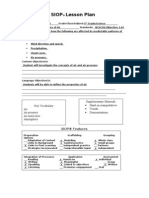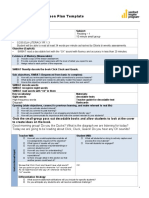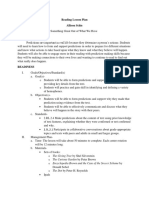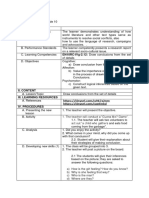0 ratings0% found this document useful (0 votes)
739 viewsEffective Vocabulary Instruction
Effective Vocabulary Instruction
Uploaded by
Hael LeighVocabulary instruction is crucial for reading comprehension. Students need to know 90-95% of words in a text to understand it. Effective vocabulary instruction includes both direct and indirect methods. Direct instruction teaches specific words, while indirect exposes students to new words through wide reading. Multiple exposures and active engagement help students learn word meanings and strategies for determining unknown words. Teachers should use a multicomponent approach including direct instruction of individual words and teaching word learning strategies.
Copyright:
© All Rights Reserved
Available Formats
Download as DOCX, PDF, TXT or read online from Scribd
Effective Vocabulary Instruction
Effective Vocabulary Instruction
Uploaded by
Hael Leigh0 ratings0% found this document useful (0 votes)
739 views3 pagesVocabulary instruction is crucial for reading comprehension. Students need to know 90-95% of words in a text to understand it. Effective vocabulary instruction includes both direct and indirect methods. Direct instruction teaches specific words, while indirect exposes students to new words through wide reading. Multiple exposures and active engagement help students learn word meanings and strategies for determining unknown words. Teachers should use a multicomponent approach including direct instruction of individual words and teaching word learning strategies.
Original Description:
vocabulary
Copyright
© © All Rights Reserved
Available Formats
DOCX, PDF, TXT or read online from Scribd
Share this document
Did you find this document useful?
Is this content inappropriate?
Vocabulary instruction is crucial for reading comprehension. Students need to know 90-95% of words in a text to understand it. Effective vocabulary instruction includes both direct and indirect methods. Direct instruction teaches specific words, while indirect exposes students to new words through wide reading. Multiple exposures and active engagement help students learn word meanings and strategies for determining unknown words. Teachers should use a multicomponent approach including direct instruction of individual words and teaching word learning strategies.
Copyright:
© All Rights Reserved
Available Formats
Download as DOCX, PDF, TXT or read online from Scribd
Download as docx, pdf, or txt
0 ratings0% found this document useful (0 votes)
739 views3 pagesEffective Vocabulary Instruction
Effective Vocabulary Instruction
Uploaded by
Hael LeighVocabulary instruction is crucial for reading comprehension. Students need to know 90-95% of words in a text to understand it. Effective vocabulary instruction includes both direct and indirect methods. Direct instruction teaches specific words, while indirect exposes students to new words through wide reading. Multiple exposures and active engagement help students learn word meanings and strategies for determining unknown words. Teachers should use a multicomponent approach including direct instruction of individual words and teaching word learning strategies.
Copyright:
© All Rights Reserved
Available Formats
Download as DOCX, PDF, TXT or read online from Scribd
Download as docx, pdf, or txt
You are on page 1of 3
At a glance
Powered by AI
Vocabulary instruction is crucial for reading comprehension. Both direct and indirect methods should be used to teach new words. Students need to learn an average of 2000-3000 new words per year.
Vocabulary knowledge is important for reading comprehension, academic success, and effective communication. Students with limited vocabularies have more difficulty understanding new concepts.
Effective vocabulary instruction should include wide reading, teaching words directly, promoting word consciousness, teaching independent word learning strategies, and exposing students to high-quality oral language.
READ 503 The Teaching of Reading
Professional Reading #1
Effective Vocabulary Instruction
Joan Sedita
Reference:
Sedita, J. (2005). Effective Vocabulary Instruction. Insights on Learning Disabilities. 2(1)
33-45. Retrieved January 14, 2015 from https://keystoliteracy.com/wpcontent/uploads/2012/08/effective-vocabulary-instruction.pdf
I. Key Words: vocabulary instruction, direct instruction, indirect instruction,
II. Summary:
Word knowledge is crucial to reading comprehension and determines how
well students will be able to comprehend the texts. Vocabulary experts agree that
adequate reading comprehension depends on a person already knowing
between 90 and 95 percent of the words in a text (Hirsch, 2003). Readers who
do not recognize at least 90 percent of the words will not only have difficulty
comprehending the text, but they will miss out on the opportunity to learn new
words.
III. Questions:
A. Literal: What is the effective vocabulary Instruction according to the
article?
1. Direct instruction means teaching specific words, such as pre-teaching
vocabulary prior to reading a selection. It is estimated that students
can be taught explicitly some 400 words per year in school (Beck,
McKeown & Kucan, 2002).
2. Indirect instruction methods, such as exposing students to lots of new
words and having them read a lot. Indirect instruction also includes
helping students develop an appreciation for words and experience
enjoyment and satisfaction in their use (Baumann, Kameenui & Ash,
2003).
B. Inferential: Why is vocabulary instruction important?
1. Vocabulary is one of five core components of reading instruction
that are essential to successfully teach children how to read. These
core components include phonemic awareness, phonics and word
study, fluency, vocabulary, and comprehension (National Reading
Panel, 2000).
2. Vocabulary knowledge is important because it encompasses all the
words we must know to access our background knowledge,
express our ideas and communicate effectively, and learn about
new concepts. Vocabulary is the glue that holds stories, ideas and
content together making comprehension accessible for children.
(Rupley, Logan & Nichols, 1998/99).
3. Students word knowledge is linked strongly to academic success
because students who have large vocabularies can understand
new ideas and concepts more quickly than students with limited
vocabularies. The high correlation in the research literature of word
knowledge with reading comprehension indicates that if students do
not adequately and steadily grow their vocabulary knowledge,
reading comprehension will be affected (Chall & Jacobs, 2003).
4. There is a tremendous need for more vocabulary instruction at all
grade levels by all teachers. The number of words that students
need to learn is exceedingly large; on average students should add
2,000 to 3,000 new words a year to their reading vocabularies
(Beck, McKeown & Kucan, 2002). For some categories of students,
there are significant obstacles to developing sufficient vocabulary to
be successful in school:
Students with limited or no knowledge of English.
Students who do not read outside of school.
Students with reading and learning disabilities.
Students who enter school with limited vocabulary
knowledge.
C. Applied: How to exhibit vocabulary instruction strategies?
1. Vocabulary instruction experts all recommend a multicomponent approach to developing vocabulary knowledge.
Graves (2000) has advocated a four-part program that
includes wide reading, teaching individual words, teaching
word learning strategies, and fostering word consciousness.
Stahls model (1999) sees vocabulary instruction as an
ongoing process that involves using different approaches:
a. Include both definitional information and
contextual information about each words
meaning.
b. Involve children more actively in word learning.
c. Provide multiple exposures to meaningful
information about the word.
2. The TRA (Teacher Reading Academy, 2002) professional
development materials were developed by the University of
Texas Center for Reading and Language Arts in Austin and
distributed throughout the country through the federally
sponsored Reading First program (part of the No Child Left
Behind legislation). The TRA materials identify the following
research-based components for effective vocabulary
instruction:
a. Encourage wide reading
b. Expose students to high-quality oral language
c. Promote word consciousness
d. Teach word meaning directly
e. Teach independent word-learning strategies,
including the use of context clues, the use of word
parts, and the efficient use of the dictionary
3. The specific vocabulary instruction strategies for:
a. Direct instruction
Wide reading: The more you read, the more
vocabulary you learn
Multiple exposure to words
Multiple exposure and importance of
background knowledge
b. Indirect instruction
Provide direct, explicit instruction in specific
words
Analyzing word structure: Teaching word parts
Use of context to determine word meaning
Teach how to effectively use a dictionary
IV. Insights/Reflections
Struggling readers and students with learning disabilities in particular have
difficulty understanding a word they are reading even with the use of dictionary needs to
be taught vocabulary. Reading this article gave me the idea to commit myself to have a
word of the day every day as starter of the class. Its hard to believe but its true, I
found out that more than 20% of the learners in my class are below their grade level
when it comes to reading. Though the number of words that students need to learn is
extremely great, an average student should add 2,000 to 3,000 new words a year to
his/her reading vocabulary (Beck, McKeown & Kucan, 2002) but I think one vocabulary
word with five synonyms and five antonyms will help a lot to add up words to the
vocabulary bank of struggling readers with learning disability.
You might also like
- SIOP Sample Lesson PlanDocument4 pagesSIOP Sample Lesson PlanAmanda Wardlow-Cosey100% (1)
- 1st Grade Lesson PlanDocument3 pages1st Grade Lesson Planklemay2009100% (1)
- Lesson Plan HomophonesDocument11 pagesLesson Plan Homophonesapi-356065858No ratings yet
- RainbowfishlessonplanDocument5 pagesRainbowfishlessonplanapi-341402633No ratings yet
- Lesson Plan Design Form11Document4 pagesLesson Plan Design Form11api-248376092No ratings yet
- Megan Ebert Final Edtpa Direct Instruction-Eled 3111Document3 pagesMegan Ebert Final Edtpa Direct Instruction-Eled 3111api-301870140No ratings yet
- SIOP Lesson PlanDocument16 pagesSIOP Lesson PlanKim GleasonNo ratings yet
- Lesson Plan Form: CCSS - ELA-Literacy - RF.K.3.cDocument3 pagesLesson Plan Form: CCSS - ELA-Literacy - RF.K.3.capi-403088205100% (1)
- Phonics For The LoraxDocument2 pagesPhonics For The Loraxlaurensr318No ratings yet
- Paraphrase RubricDocument2 pagesParaphrase RubricHael Leigh100% (2)
- Research Final Manuscript FormatDocument7 pagesResearch Final Manuscript FormatHael Leigh67% (3)
- Summarizing RubricDocument1 pageSummarizing RubricHael LeighNo ratings yet
- Rubric For An AbstractDocument3 pagesRubric For An AbstractHael LeighNo ratings yet
- Research QuestionsDocument9 pagesResearch QuestionsHael Leigh100% (7)
- Importance of Quantitative ResearchDocument3 pagesImportance of Quantitative ResearchHael Leigh83% (59)
- Competence of Mathematics Teachers in The Private Secondary Schools in The City of San Fernando, La Union: Basis For A Two-Pronged Training ProgramDocument245 pagesCompetence of Mathematics Teachers in The Private Secondary Schools in The City of San Fernando, La Union: Basis For A Two-Pronged Training ProgramFeljone Ragma75% (4)
- Eisner's ModelDocument13 pagesEisner's ModelJoan Patrice Mondarez Mangalile83% (6)
- Lesson Plan - PharmacyDocument5 pagesLesson Plan - PharmacyarhcolawNo ratings yet
- DCSF Teaching Effective VocabularyDocument16 pagesDCSF Teaching Effective VocabularyMatt GrantNo ratings yet
- What Every Educator and Parent Should Know About Reading InstructionDocument7 pagesWhat Every Educator and Parent Should Know About Reading InstructionWilliam WangNo ratings yet
- Whole Group Shared Reading Lesson Plan TemplateDocument4 pagesWhole Group Shared Reading Lesson Plan Templateapi-300874571No ratings yet
- Briley Shinlever Lessonplan Educ216Document5 pagesBriley Shinlever Lessonplan Educ216api-287789432No ratings yet
- Grammar Lesson Prefixes 2017Document7 pagesGrammar Lesson Prefixes 2017api-340592260No ratings yet
- Social Studies LessonDocument4 pagesSocial Studies Lessonapi-354685236No ratings yet
- Personal Narrative Lesson Plan 5th GradeDocument2 pagesPersonal Narrative Lesson Plan 5th Gradeapi-252519456No ratings yet
- Writing Lesson Plan April 26thDocument3 pagesWriting Lesson Plan April 26thapi-3566001480% (1)
- Interactive Notebook and PortfoliosDocument4 pagesInteractive Notebook and Portfolioseva.bensonNo ratings yet
- Multi Step Word Problems No Problem PDFDocument8 pagesMulti Step Word Problems No Problem PDFJonalynNo ratings yet
- Giao An Tieng Anh 11Document156 pagesGiao An Tieng Anh 11Carter RuanNo ratings yet
- Siop Lesson Plan ConstituionDocument4 pagesSiop Lesson Plan Constituionapi-522436376No ratings yet
- Third Grade Comprehensive Unit Plan Andrew Langhorne Stephanie Shipp Meghan Tomasi Sarah Wolfe James Madison UniversityDocument17 pagesThird Grade Comprehensive Unit Plan Andrew Langhorne Stephanie Shipp Meghan Tomasi Sarah Wolfe James Madison Universityapi-334275716No ratings yet
- A Semi-Detailed Lesson Plan in Sentence Structure I. ObjectivesDocument3 pagesA Semi-Detailed Lesson Plan in Sentence Structure I. ObjectivesJeremie GermanNo ratings yet
- Lesson 22 - ElaDocument11 pagesLesson 22 - Elaapi-357400202No ratings yet
- Lesson With Teaching Goals and Reflection WDocument7 pagesLesson With Teaching Goals and Reflection Wapi-296133021No ratings yet
- Informal Assessment #1 Standard:: CC.1.1.K.DDocument4 pagesInformal Assessment #1 Standard:: CC.1.1.K.DDanelle LockeNo ratings yet
- Project-Based Learning From Theory To EFLClassroomPracticeDocument14 pagesProject-Based Learning From Theory To EFLClassroomPracticeMabel QuirogaNo ratings yet
- Millicent Atkins School of Education: Common Lesson Plan TemplateDocument8 pagesMillicent Atkins School of Education: Common Lesson Plan Templateapi-346286339No ratings yet
- Siop - Science Lesson Plan 5th GradeDocument4 pagesSiop - Science Lesson Plan 5th GradeReginald JacksonNo ratings yet
- Non FictionDocument5 pagesNon Fictionapi-329737382No ratings yet
- Reading Fluency LessonsDocument11 pagesReading Fluency Lessonsapi-310225789No ratings yet
- Siop Lesson Plan Wida Level 3Document6 pagesSiop Lesson Plan Wida Level 3api-248121250No ratings yet
- Study SkillsDocument82 pagesStudy SkillslathanhvienNo ratings yet
- Learning Segment-Ela 3Document10 pagesLearning Segment-Ela 3api-254944388No ratings yet
- Process-Writing - A Strategic Approach To Text ProductionDocument4 pagesProcess-Writing - A Strategic Approach To Text ProductionLidia FloresNo ratings yet
- DR Seuss Lesson Plan - Alyssa 2016Document3 pagesDR Seuss Lesson Plan - Alyssa 2016api-272228988No ratings yet
- Lesson Plans For Week Long Literacy BlockDocument10 pagesLesson Plans For Week Long Literacy Blockapi-3031259470% (1)
- Guided Reading - Dra AssignmentDocument7 pagesGuided Reading - Dra Assignmentapi-286060600No ratings yet
- Siop Lesson PlanDocument4 pagesSiop Lesson Planapi-522660867No ratings yet
- Geography Lesson PlanDocument4 pagesGeography Lesson Planapi-282153633No ratings yet
- Differentiation AssignmentDocument14 pagesDifferentiation Assignmentapi-545465429No ratings yet
- Millicent Atkins School of Education: Common Lesson Plan TemplateDocument7 pagesMillicent Atkins School of Education: Common Lesson Plan Templateapi-332459220No ratings yet
- Reading Lesson Plan Allison Schie UNIT BIG IDEA: Making Something Great Out of What We Have Lesson RationaleDocument8 pagesReading Lesson Plan Allison Schie UNIT BIG IDEA: Making Something Great Out of What We Have Lesson Rationaleapi-351448195No ratings yet
- Literature Review Domain ADocument2 pagesLiterature Review Domain Aapi-248376092No ratings yet
- Ell Classroom Observation ReportDocument3 pagesEll Classroom Observation Reportapi-262715288No ratings yet
- Techniques For Teaching Writing SkillsDocument21 pagesTechniques For Teaching Writing SkillsMissBigHead100% (3)
- Grade 2 Literacy Curriculum PDFDocument17 pagesGrade 2 Literacy Curriculum PDFhlariveeNo ratings yet
- Money Lesson SequenceDocument10 pagesMoney Lesson Sequenceapi-366373073No ratings yet
- Highlight Relevant Parts of The Standards That Relate Directly To Your Lesson ObjectivesDocument4 pagesHighlight Relevant Parts of The Standards That Relate Directly To Your Lesson Objectivesapi-283979987No ratings yet
- Edu 371 Udl Unit PlanDocument18 pagesEdu 371 Udl Unit Planapi-359110943No ratings yet
- Lesson Plan Fresh Fruits Year 3 WritingDocument5 pagesLesson Plan Fresh Fruits Year 3 WritingSarah Love100% (1)
- Learning Segment-Ela 2Document10 pagesLearning Segment-Ela 2api-254944388No ratings yet
- SIOP Lesson PlanDocument4 pagesSIOP Lesson PlanPayton BallNo ratings yet
- Lesson and Assessment Plan Us Observation 2 - Darius WimbyDocument7 pagesLesson and Assessment Plan Us Observation 2 - Darius Wimbyapi-291004299No ratings yet
- Final Edtpa Direct Lesson Plan DwilliamsDocument3 pagesFinal Edtpa Direct Lesson Plan Dwilliamsapi-295821640100% (1)
- Tips For TeachingDocument11 pagesTips For TeachingAna AlmeidaNo ratings yet
- 10 Geography Lesson Plans for KS1 - Volume 1: Our School and the Local Area & An Island HomeFrom Everand10 Geography Lesson Plans for KS1 - Volume 1: Our School and the Local Area & An Island HomeNo ratings yet
- INTRODUCTION TO EDUCATION (FOUNDATIONS OF): Passbooks Study GuideFrom EverandINTRODUCTION TO EDUCATION (FOUNDATIONS OF): Passbooks Study GuideNo ratings yet
- Reflection RubricDocument2 pagesReflection RubricHael Leigh100% (1)
- Problem and Solution Essay RubricDocument1 pageProblem and Solution Essay RubricHael Leigh100% (1)
- 10thweekDLL EAPPDocument3 pages10thweekDLL EAPPHael Leigh100% (1)
- 20thweekDLL EAPPDocument2 pages20thweekDLL EAPPHael Leigh100% (1)
- Research Article Synthesis Individual Activity 1Document1 pageResearch Article Synthesis Individual Activity 1Hael LeighNo ratings yet
- Practical Research 2: This Course Develops Critical Thinking and Problem-Solving Skills Through Quantitative ResearchDocument31 pagesPractical Research 2: This Course Develops Critical Thinking and Problem-Solving Skills Through Quantitative ResearchHael Leigh25% (4)
- Oral ReportsDocument10 pagesOral ReportsHael LeighNo ratings yet
- Cause and Effect Essay RubricDocument1 pageCause and Effect Essay RubricHael Leigh100% (1)
- 1stweek Intro Quanti Vs QualiDocument18 pages1stweek Intro Quanti Vs QualiHael LeighNo ratings yet
- Direct Quote RubricDocument1 pageDirect Quote RubricHael LeighNo ratings yet
- 1stweekDLL EAPPDocument2 pages1stweekDLL EAPPHael Leigh100% (3)
- 3rdweek VariablesDocument18 pages3rdweek VariablesHael Leigh75% (4)
- 12 - ICT 12 - HE: I. ObjectivesDocument3 pages12 - ICT 12 - HE: I. ObjectivesHael Leigh100% (1)
- The Effects of Using Technology On Students Motivation in Their Study Submitted byDocument8 pagesThe Effects of Using Technology On Students Motivation in Their Study Submitted byHael LeighNo ratings yet
- Technical ReportsDocument14 pagesTechnical ReportsHael LeighNo ratings yet
- Conceptual and Theoretical FrameworkDocument6 pagesConceptual and Theoretical FrameworkHael LeighNo ratings yet
- 5thweekDLL EAPPDocument3 pages5thweekDLL EAPPHael LeighNo ratings yet
- Journal Title: Author: Research Instrument/s APA Referencing Data Analysis MethodDocument2 pagesJournal Title: Author: Research Instrument/s APA Referencing Data Analysis MethodHael LeighNo ratings yet
- Hypothesis and Assumptions of The StudyDocument9 pagesHypothesis and Assumptions of The StudyHael Leigh0% (1)
- 4thweekDLL EAPPDocument3 pages4thweekDLL EAPPHael LeighNo ratings yet
- Attended in at Least Two (2) Community Events/activities (2.5%)Document1 pageAttended in at Least Two (2) Community Events/activities (2.5%)Hael LeighNo ratings yet
- Quiz in Propaganda TechniquesDocument1 pageQuiz in Propaganda TechniquesHael LeighNo ratings yet
- Edited Guidelines in The Filling Out of SALNDocument42 pagesEdited Guidelines in The Filling Out of SALNHael LeighNo ratings yet
- Sbm-Action PlanDocument1 pageSbm-Action PlanHael Leigh100% (35)
- Diploma in Elementary Education (D.El - Ed) Exam Result PDFDocument1 pageDiploma in Elementary Education (D.El - Ed) Exam Result PDFAnonymous 8e99IuqayNo ratings yet
- Maam TALISIC SCIENCEDocument3 pagesMaam TALISIC SCIENCEJenny Zyler ZionNo ratings yet
- University of Mindanao: Self-Instructional Manual (SIM) For Self-Directed Learning (SDL)Document110 pagesUniversity of Mindanao: Self-Instructional Manual (SIM) For Self-Directed Learning (SDL)IrisYamagushiHaruki-ChanXDNo ratings yet
- Action Plan in Reading 2023Document3 pagesAction Plan in Reading 2023girlie mae pondias100% (2)
- My Discovery Chart On Field Study 2 A Joyful Teaching-Learning JourneyDocument3 pagesMy Discovery Chart On Field Study 2 A Joyful Teaching-Learning JourneyJohann Emmanuel Molato100% (1)
- G10 Fashion Accessories DLP Q2-Day5Document3 pagesG10 Fashion Accessories DLP Q2-Day5Jane Seneca-EnriquezNo ratings yet
- The Teacher and The LearnerDocument23 pagesThe Teacher and The LearnerUnique Alegarbes Labra-SajolNo ratings yet
- Lesson Plan For Drawing ConclusionDocument3 pagesLesson Plan For Drawing ConclusionLaurens Nobels100% (2)
- Collaborative Work Skills RubricDocument3 pagesCollaborative Work Skills Rubricapi-315713868No ratings yet
- Lessonplan KotaDocument11 pagesLessonplan Kotaapi-377854628No ratings yet
- Teaching ResumeDocument1 pageTeaching Resumeapi-437442578No ratings yet
- 3rd Grade Citizenship Social Studies Lesson PlanDocument2 pages3rd Grade Citizenship Social Studies Lesson Planleahbrom100% (3)
- Module Pe3 (Service Pe)Document2 pagesModule Pe3 (Service Pe)Hannah Faye DairoNo ratings yet
- Cantilan National High School: 3 QuarterDocument2 pagesCantilan National High School: 3 QuarterJazel Sheen SapurasNo ratings yet
- Action PlanDocument1 pageAction PlanArgie Corbo BrigolaNo ratings yet
- Assessment PlanDocument1 pageAssessment Planapi-269682032No ratings yet
- Module 1 Lesson 2: Exercise 1Document2 pagesModule 1 Lesson 2: Exercise 1Maria Cristina ImportanteNo ratings yet
- SyllabusDocument2 pagesSyllabusapi-261709282No ratings yet
- Evaluating Algebraic ExpressionsDocument7 pagesEvaluating Algebraic ExpressionsKarlzNo ratings yet
- Teaching Philosophy Statement: Emily ByrneDocument11 pagesTeaching Philosophy Statement: Emily ByrneLiezel Gajutos SaldoNo ratings yet
- Curriculum ImplementationDocument62 pagesCurriculum ImplementationJESUSA SANTOSNo ratings yet
- Lesson 1 The Remedial Classroom Organization and ManagementDocument2 pagesLesson 1 The Remedial Classroom Organization and ManagementGleann Corpuz91% (11)
- Homeroom Guidance LearnerDocument2 pagesHomeroom Guidance LearnerJing AbelaNo ratings yet
- Lesson 4 The Teaching CycleDocument11 pagesLesson 4 The Teaching CycleBhea Mae EstayoNo ratings yet
- Practice Teaching Learning Episode: NCBTS Domains 1, 2, 3, 7Document9 pagesPractice Teaching Learning Episode: NCBTS Domains 1, 2, 3, 7Geronimo RamojalNo ratings yet
- For INSET 2019Document20 pagesFor INSET 2019Jocelyn Petallar Balasuela100% (1)
- Production Crew RubricDocument2 pagesProduction Crew Rubricapi-240411472No ratings yet























































































































